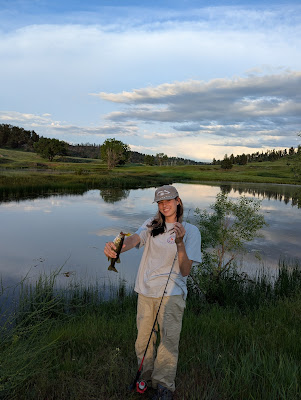Stewardship on the Prairie: Balancing Ranching and Restoration
Guest post by Clemson student Mia Bonfili
Change is inevitable — a truth that Montana ranchers know all too well, and whether it is good or bad time, will only tell. Over the past few days, we’ve spent hours meeting with a wide range of people, from conservation and restoration organizations to multi-generational ranchers, and not to mention camping on the prairie itself. I’ve only been to Montana once before, and while I took in the landscape and saw the prairie, it’s only now—returning for a second time—that I’m beginning to truly understand what the 'Great Prairie' really means.
Before I get into what I believe the true definition is, it is important to understand the different roles that play into this landscape. For instance you may see “Save the Cowboy” or “Stop the APR” going through towns like Malta or Lewistown. These signs are much more than flashy phrases on the side of the road, they are reflective of the tension between the historic land and people. This tension often stems from concerns that large-scale conservation efforts might displace local communities or limit their traditional use of the land.
For the first section of this course, our group spoke to the Nature Conservancy about their goal to create more “grassbanks”, a tool used to help incentivize ranchers adopt different conservation efforts as well as let them graze their cattle on high-quality forage on the Matador Ranch. This all in effort to reduce the plowing of native grasslands and increase the prairie dog populations while contributing to lowering economic costs to ranchers across Montana.
On the other hand, we met with Leo and Martin on Leo’s ranch past Malta. Both men were part of the RSA (Rancher’s Stewardship Alliance), based out of Malta, MT, which is dedicated to building relationships between different ranchers, supporting grassland conservation, and promoting stewardship of both the land and its animals. While it is not as progressive in structure as the Nature Conservancy, RSA takes a traditional approach to conservation, encouraging strong management and providing educational outreach to their rural communities. Ranching is more than just a livelihood for many of these families — it’s their lifeline. Leo referred to it as his “bread and butter,” a phrase used by many others as well who depend on the land not only for income but as their way of life.
In my opinion, organizations like RSA are essential because they uplift the people who already know the land intimately. Ranchers have been quietly stewarding these prairies for generations, and rather than pushing them out or overriding their practices, it’s far more effective — and respectful — to work with them and their families. However, prairie conservation is just as important for the longevity of the entire ecosystem, in addition to the wildlife that depends on it. These natural grasslands sustain fast declining biodiversity, storing carbon and so on. A significant portion of North America's ecological and cultural legacy would be lost if the grassland disappeared.
In addition, we met with representatives from the American Prairie Reserve (APR), an ambitious organization with the mission of creating one of the largest nature reserves in the United States. Their goal is to conserve and restore the native grasslands of the Northern Great Plains by reestablishing a fully functioning prairie ecosystem. This includes reintroducing bison, a keystone species whose last truly wild population in the region was eradicated around 1870 — and supporting the return of other native wildlife to the area too. In Lewistown, at the American Prairie Center, we met with Randy Matchett, a wildlife biologist who is deeply involved in many of APR’s species recovery efforts. One of his key projects focuses on the re-population of the endangered black-footed ferret, a species that depends on thriving prairie dog colonies and intact grassland ecosystems. We also had the opportunity to contribute directly to one of APR's current conservation efforts. We assisted with the usage of white and black markers to tag barbed wire fences as part of their sage grouse project. These indicators are a simple but critical technique for preventing collisions among these low-flying birds, reducing collisions by 83%.
Aside from APR, we had the opportunity to meet other researchers that work directly with animals such as prairie dogs and Sprague's pipit, both of which are rapidly disappearing from grassland habitats. Listening to these experts describe their work highlighted how important and linked the prairie ecosystem is. The survival of one species frequently depends on the presence of another, and maintaining this balance requires collaboration among researchers, landowners, and conservationists alike.
So, what does the name "Great American Prairie" genuinely mean? It's more than simply open space; it's a seriously complex, living system influenced by wildlife, ranchers, and years of stewardship between both. It symbolizes dedication, collaboration, and the balance between conservation and community. To me, the prairie's survival is dependent not on one group, but on the eagerness (and the openness) of many - to listen, learn, and care for something larger than themselves.



